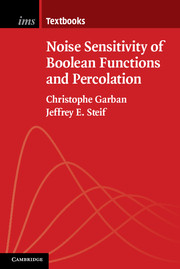Book contents
- Frontmatter
- Dedication
- Contents
- Preface
- Notations
- 1 Boolean functions and key concepts
- 2 Percolation in a nutshell
- 3 Sharp thresholds and the critical point for 2-d percolation
- 4 Fourier analysis of Boolean functions (first facts)
- 5 Hypercontractivity and its applications
- 6 First evidence of noise sensitivity of percolation
- 7 Anomalous fluctuations
- 8 Randomized algorithms and noise sensitivity
- 9 The spectral sample
- 10 Sharp noise sensitivity of percolation
- 11 Applications to dynamical percolation
- 12 For the connoisseur
- 13 Further directions and open problems
- References
- Index
8 - Randomized algorithms and noise sensitivity
Published online by Cambridge University Press: 18 December 2014
- Frontmatter
- Dedication
- Contents
- Preface
- Notations
- 1 Boolean functions and key concepts
- 2 Percolation in a nutshell
- 3 Sharp thresholds and the critical point for 2-d percolation
- 4 Fourier analysis of Boolean functions (first facts)
- 5 Hypercontractivity and its applications
- 6 First evidence of noise sensitivity of percolation
- 7 Anomalous fluctuations
- 8 Randomized algorithms and noise sensitivity
- 9 The spectral sample
- 10 Sharp noise sensitivity of percolation
- 11 Applications to dynamical percolation
- 12 For the connoisseur
- 13 Further directions and open problems
- References
- Index
Summary
In this chapter, we explain how the notion of revealment for so-called randomized algorithms can in some cases yield direct information concerning the energy spectrum that may allow not only noise sensitivity results but even quantitative noise sensitivity results.
BKS and randomized algorithms
In the previous chapter, we explained how Theorem 1.21 together with bounds on the pivotal exponent for percolation yields noise sensitivity for percolation crossings. However, in (BKS99), a different approach was in fact used for showing noise sensitivity which, while still using Theorem 1.21, did not use these bounds on the critical exponent. In that approach, one sees the first appearance of randomized algorithms. In a nutshell, the authors showed that (1) if a monotone function is very uncorrelated with all majority functions, then it is noise sensitive (in a precise quantitative sense) and (2) percolation crossings are very uncorrelated with all majority functions. The latter is shown by constructing a certain algorithm which, due to the RSW Theorem 2.1, looks at very few bits but still looks at enough bits to be able to determine the output of the function. This approach is detailed in Section 12.13 in Chapter 12.
The revealment theorem
An algorithm for a Boolean function f is an algorithm A that queries (asks the values of) the bits one by one, where the decision of which bit to ask can be based on the values of the bits previously queried, and stops once f is determined (being determined means that f takes the same value no matter how the remaining bits are set).
A randomized algorithm for a Boolean function f is the same as above but auxiliary randomness may also be used to decide the next value queried (including for the first bit). [In computer science, the term randomized decision tree would be used for our notion of randomized algorithm, but we will not use this terminology.]
- Type
- Chapter
- Information
- Noise Sensitivity of Boolean Functions and Percolation , pp. 82 - 95Publisher: Cambridge University PressPrint publication year: 2014

